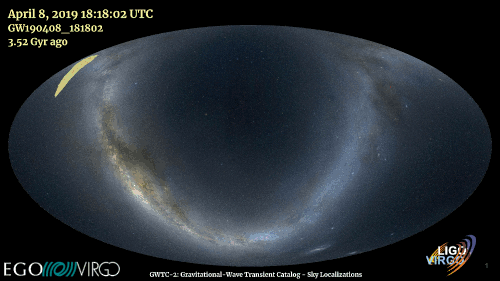Gravitational Waves: astrophysics, source modeling, data analysis, construction of the Virgo detector
In May 2023, shortly after the start of the fourth LIGO-Virgo-KAGRA observing run, the LIGO Livingston detector observed a gravitational-wave signal from the collision of what is most likely a neutron star with a compact object that is 2.5 to 4.5 times the mass of our Sun. Neutron stars and black holes are both compact objects, the dense remnants of massive stellar explosions. What makes this signal, called GW230529, intriguing is the mass of the heavier object.
Next week, the LIGO and Virgo detectors will resume their observing campaigns, which promise to collect more than 200 gravitational-wave events by the end of this current observing run (O4). Astronomers also hope that new multi-messenger events will be detected. Multi-messenger events are those observed both in gravitational and electromagnetic waves, and can be further followed up by other telescopes.
The LIGO-Virgo-KAGRA Collaboration will begin the second part of its fourth observing run (O4b) on April 10th.
The LIGO-Virgo-KAGRA collaboration has published the results of the search for continuous gravitational waves in the data from the entire O3 observational campaign. It is expected that such waves can be emitted by e.g. axially asymmetric neutron stars, but their amplitude is much smaller than the regularly observed, short-term signals emitted during black hole mergers. For this reason, they have not been observed so far. In this publication, we present the results of four independent methods obtained by various research groups that carried out the so-called blind searches in a wide range of parameters: all sky, frequency range from 10 to 2048 Hz and rate of frequency change from $-10^{- 8}$ to $10^{- 9}$ Hz / s.
The Virgo, LIGO and KAGRA scientific collaborations today announced the first observation ever of binary systems consisting of a neutron star (NS) and a black hole (BH). This was made possible by the detection, in January 2020, of gravitational signals (nicknamed GW200105 and GW200115 from the dates of their detection) emitted by two systems, in which a black hole and a neutron star, rotating around each other, merged into a single compact object.
The classification and definitive analysis of the 39 events detected by Virgo and LIGO in the third observation period (which ran from April to October 2019) was published today on the ArXiv online archive. Most of these are black hole mergers, the characteristics of which, however, question some established astrophysical models and open up new scenarios. A likely merger of neutron stars and two probable ‘mixed’ neutron star-black hole systems were also detected in the same period.
Virgo and LIGO have announced the detection of an extraordinarily massive merging binary system: two black holes of 66 and 85 solar masses, which generated a final black hole of 142 solar masses. The remnant lies in a range of mass that has never before been observed, either via gravitational waves or with electromagnetic observations.
The final black hole is the most massive ever detected with gravitational waves.
The breaking of the mass record of the Virgo and LIGO observational runs is just one of the many special features that make the detection of this exceptional merger an unprecedented discovery.






